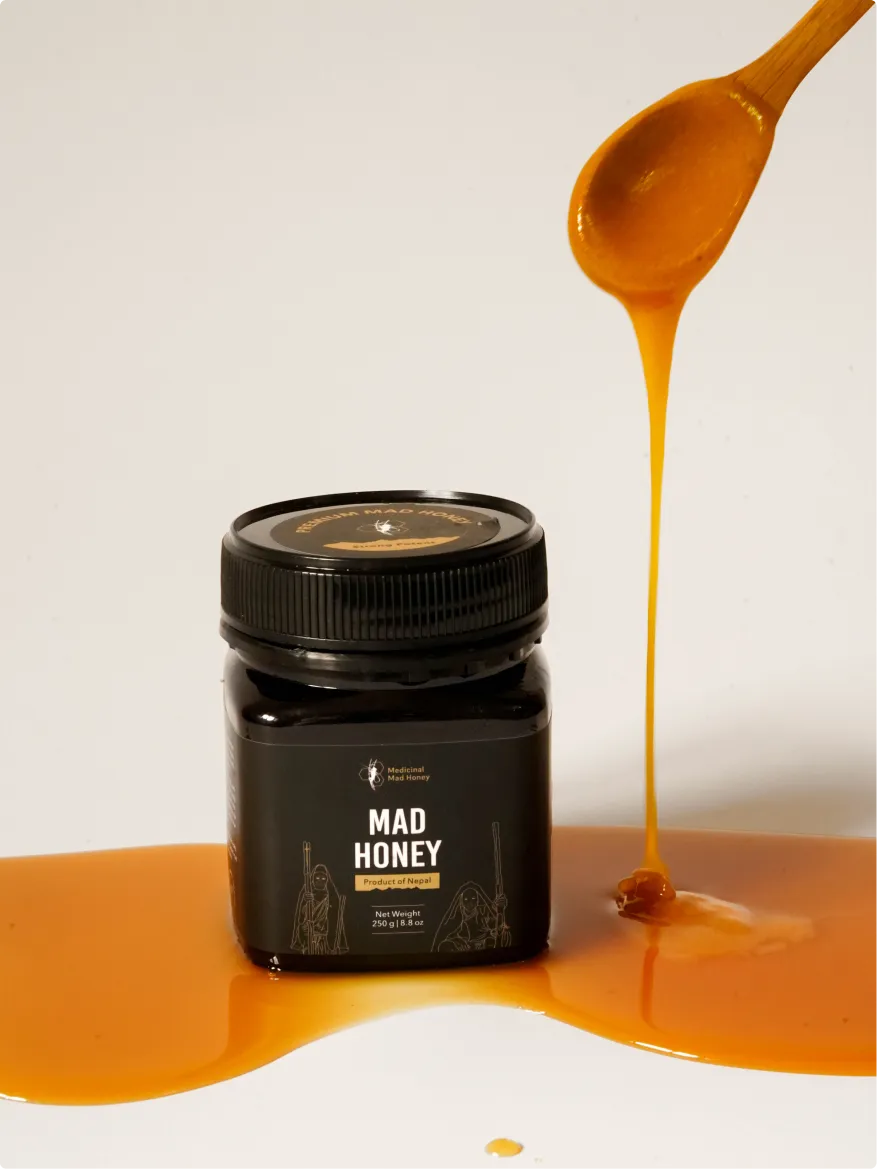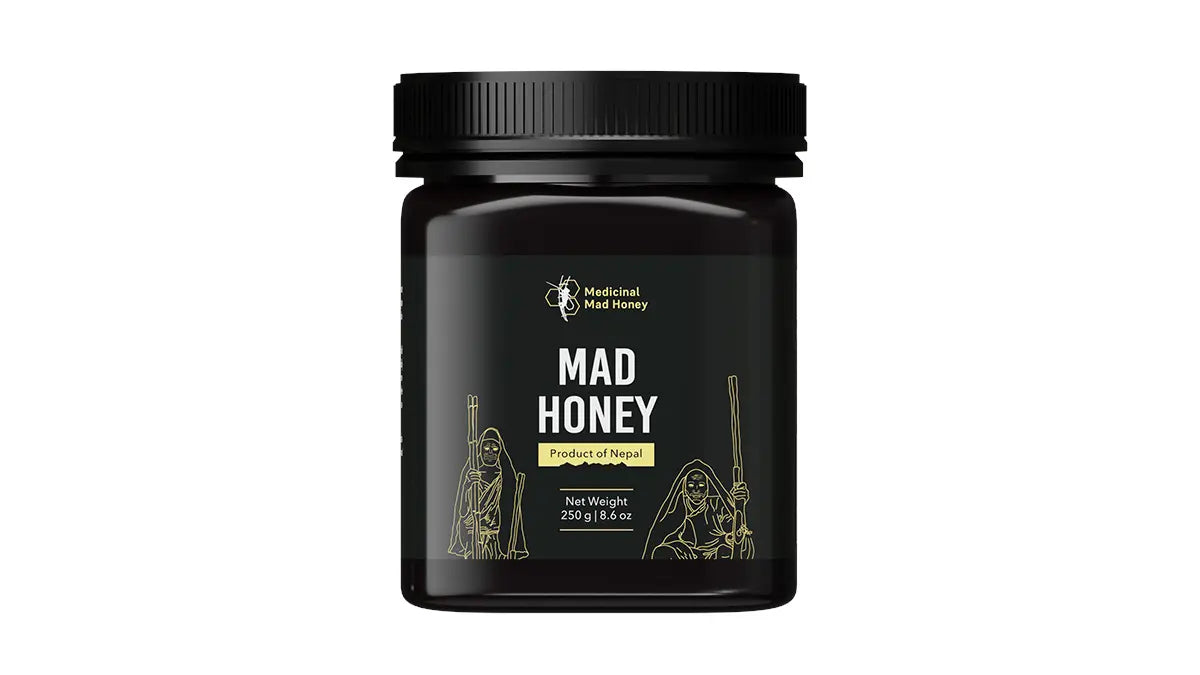The high price of a small bottle of honey is usually a matter of concern. While mad honey is the rarest honey in the world, it also happens to be among one of the most expensive honey varieties in the world. The price may put anyone under suspicion, but there are several factors that can explain why this special honey is priced that way. One major factor is its psychoactive properties, followed by its special health benefits. In this article, we will explore all the reasons why mad honey is so expensive.
Reasons Behind the high price of Mad Honey
1. The Rarity of Mad Honey
Mad honey is produced by Himalayan Giant Honey Bees (Apis Laboriosa) especially from the nectar of rhododendron and other flowers found in high altitudes in Nepal and Turkey. Additionally, the most notable thing that makes it different is the existence of grayanotoxins, a substance found in rhododendron nectar. Mad honey therefore can only be produced in certain areas and is subject to the flowering of rhododendron which occurs during a limited flowering period usually in the spring. This narrow geographic and time scope is one of the factors that make it expensive.

2. Difficulty in Honey Hunting
Harvesting of Mad Honey is a strenuous process to the hunters because of a number of challenges. To start with, the Himalayan regions where Mad Honey exists are remote and rugged thus accessing the honeycombs is very risky. Honey hunters are time bound, and the activity is a risky one. The very process is extremely physically demanding, involves bravery, and conventional skills, which are frequently handed down through generations.
3. Time-Consuming Process:
Mad Honey is difficult and time-consuming to collect. It takes several days of journey to the far mountainous areas to access the honeycombs by the honey hunters. After reaching the place, it takes more time to prepare and plan before the real harvest. The process of climbing cliffs is even more strenuous and skilled honey hunters of the Gurung community use rudimentary equipment such as ropes and bamboo ladders to reach these high-altitude cliffs making the whole process even more time-consuming and physically tiring. The collected mad honey must then be brought out of the remote location and properly processed to comply with the strict rules and safety regulations of food regulatory bodies.
4. Growing Demand and Limited Supply
The demand of Mad Honey has exploded in recent years, as it is said to have a distinct flavor and is also said to have positive health effects. The very name of mad is something that would attract attention and the soft psychedelic effects that the honey produces, leaving most people with an euphoric feeling are what makes many people want to at least taste it once. This increased interest has created a major shortage in supply, since Mad Honey is a completely natural product and is produced in limited quantities by giant honeybees in restricted high altitude zones. The fact that it is getting more and more popular in the world market and that the production is limited has only made it even more rare and increased its prices.
5. High Quality and Safety Assurance
The quality and safety of mad honey are the most important. The selling companies as well as the accredited labs conduct stringent tests. These tests include such points as purity, nutrition, lack of contaminants and compliance with safe levels of Grayanotoxins. The industry standards of cleanliness and safety are also important, as well as certification. Mad honey has to be of high organic certification and must not have any artificial additives or pesticides in it. Such quality controls and safety requirements increase the cost of selling mad honey.
If you want to know about the mad honey with high quality and safety assurance, here we have simplified an article on the topic of five best mad honey brands for you to buy and try.
Conclusion
To sum up, Mad Honey is not only a delicious food but a precious and carefully collected natural product. Its price may be explained by a number of factors: its scarcity in geographic terms, the great difficulties of honey hunting, the labor-intensive means of collection, the rising demand in the world market, and the high quality standards. The main reason why this special honey is so costly is the growing demand to use Mad Honey as a wellness product and recreational drug, and the fact that the supply has not been able to match the demand.
Every Jar of mad honey is a testimony of the uniqueness of nature and the effort of people who introduce this extraordinary honey to the market. Next time you enjoy a jar of mad honey, then, remember the work and attention that is put into the creation of this golden liquid.
FAQs
Is the Expensive Mad Honey Worth a try?
Yes, mad honey experience is totally unique and worth a try. The Mad Honey is expensive because the high price is influenced by rarity, nutritional content, extensive labor and dangers associated with it. Although the health benefits of Mad Honey is notable, has some uses for recreational purpose but there is a clear sign of Mad Honey side effects when overdosed.
How expensive is mad honey?
The costs of premium mad honey can go somewhere between 150$ to 350$ per KG based on the brand, potency, packaging and location. Although this is not the standard pricing and hence can vary between available different brands on the market. Based on sourcing, production cost, country or region of mad honey origin and availability, the cost of Mad Honey can differ from one brand to another.
This is the exact reason, why there is difference in Mad Honey Prices between different brands.
Can I get Mad Honey at Wholesale price for resale purpose?
Yes, you can even go for bulk buy of mad honey at wholesale price which can be an exciting partnership with Medicinal Mad Honey.
How can I buy Mad Honey at cheaper pricing?
Mad Honey can't just be cheaper from the regular pricing. However Mad Honey companies like Medicinal Mad Honey offers timely promo codes on special occasions and there is an existing A special 10% off on your first order! with a coupon code "WELCOME10" where every users can get 10% off on first order of mad honey.
Done Buying Mad Honey? Check how much mad honey should you take?





